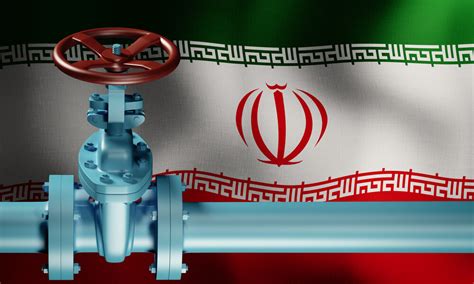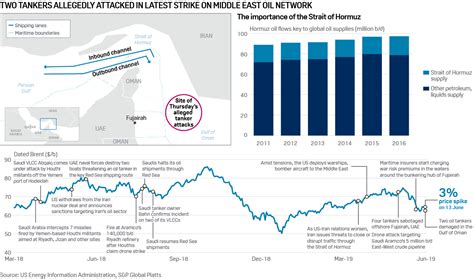
Oil prices jumped and concerns about global trade intensified following escalating tensions between the United States and Iran, raising the specter of a potential closure of the Strait of Hormuz, a critical chokepoint for global energy supplies. While the waterway remains open, recent saber-rattling and heightened military activity have created significant uncertainty.
The Strait of Hormuz, a narrow waterway between Oman and Iran, serves as the passage for approximately 20% of the world’s total oil consumption. Any disruption to traffic through the Strait could have severe repercussions for the global economy, triggering a surge in energy prices, disrupting supply chains, and potentially leading to broader geopolitical instability.
The current tensions stem from a series of events, including recent attacks and counterattacks in the region and heightened rhetoric from both Washington and Tehran. Although no official closure has been declared, the risk of miscalculation or escalation remains a significant concern, particularly given the history of confrontations in the area. “Whether the key waterway will close is less clear,” reports Yahoo Finance, highlighting the precarious nature of the situation.
Heightened Tensions and Military Posturing
The recent uptick in tensions has been characterized by increased military activity and assertive statements from both sides. Iran has previously threatened to close the Strait of Hormuz in response to sanctions and perceived threats to its national security. These threats have often coincided with periods of heightened tensions with the United States and its allies.
The US Navy maintains a significant presence in the Persian Gulf and surrounding waters, tasked with ensuring freedom of navigation and deterring hostile actions. The presence of US warships and aircraft carriers serves as a deterrent but also increases the risk of accidental encounters or misinterpretations that could escalate the situation.
Iranian military forces, including the Islamic Revolutionary Guard Corps (IRGC), possess a range of capabilities that could be used to disrupt traffic through the Strait. These include anti-ship missiles, fast attack craft, and naval mines. The IRGC has also conducted numerous exercises in the area, simulating the closure of the Strait and demonstrating its ability to project power in the region.
“The US has accused Iran of harassing commercial ships in the area, while Iran has accused the US of interfering with its shipping activities,” according to Yahoo Finance. These mutual accusations further contribute to the climate of distrust and increase the likelihood of miscalculations.
Economic Implications of a Potential Closure
The closure of the Strait of Hormuz would have profound economic consequences, particularly for countries heavily reliant on oil imports from the Persian Gulf region. Asia, in particular, would be acutely affected, as countries like China, India, Japan, and South Korea depend on the Strait for a significant portion of their energy needs.
Oil prices would likely surge dramatically in the event of a closure, potentially exceeding previous record highs. This would lead to higher gasoline prices for consumers, increased costs for businesses, and inflationary pressures throughout the global economy. Airlines, transportation companies, and other energy-intensive industries would be particularly vulnerable.
Beyond the immediate impact on oil prices, a closure of the Strait could also disrupt global trade flows and supply chains. Many goods and commodities pass through the Strait, and any interruption to traffic could have ripple effects across various industries.
The impact on global financial markets would also be significant. Stock markets would likely decline, and investors would seek safe-haven assets such as gold and government bonds. The value of currencies in countries heavily reliant on oil imports could also come under pressure.
Geopolitical Ramifications
The closure of the Strait of Hormuz would not only have economic consequences but also significant geopolitical ramifications. It could escalate tensions between the United States and Iran, potentially leading to military conflict. It could also draw in other regional and international actors, further destabilizing the region.
The United States has repeatedly stated that it will not allow Iran to close the Strait of Hormuz and has vowed to use military force if necessary to keep the waterway open. However, any military intervention could have unintended consequences and could lead to a wider conflict.
Other countries, including China, Russia, and European nations, have a vested interest in maintaining stability in the region and ensuring freedom of navigation through the Strait. These countries could play a mediating role in de-escalating tensions and preventing a closure of the Strait.
“The closure of the Strait of Hormuz would be a major escalation that could lead to a wider conflict in the region,” says Yahoo Finance, underscoring the gravity of the situation.
Alternative Routes and Mitigation Strategies
In the event of a prolonged closure of the Strait of Hormuz, alternative routes and mitigation strategies would become crucial. These include:
- Increasing oil production from other regions: Countries like the United States, Canada, and Brazil could increase their oil production to help offset the loss of supplies from the Persian Gulf.
- Releasing strategic petroleum reserves: Governments could release oil from their strategic petroleum reserves to help stabilize prices and ensure adequate supplies.
- Utilizing alternative pipeline routes: Several pipelines exist that can transport oil from the Persian Gulf to other regions, bypassing the Strait of Hormuz. These include the Petroline pipeline in Saudi Arabia and the Baku-Tbilisi-Ceyhan pipeline.
- Increasing the use of alternative energy sources: Governments and businesses could accelerate the transition to renewable energy sources to reduce their reliance on oil.
- Improving energy efficiency: Measures to improve energy efficiency, such as investing in energy-efficient technologies and promoting energy conservation, could help reduce overall energy demand.
However, these alternative routes and mitigation strategies are unlikely to fully compensate for the loss of supplies from the Persian Gulf, and the impact on global energy markets would still be significant.
Historical Context and Previous Incidents
The Strait of Hormuz has been a flashpoint for tensions in the region for decades. In the 1980s, during the Iran-Iraq War, both sides attacked oil tankers passing through the Strait in what became known as the “Tanker War.”
In 1988, the US Navy shot down an Iranian passenger plane over the Strait of Hormuz, killing all 290 people on board. The US claimed that the plane was mistaken for an Iranian fighter jet, while Iran maintained that the shooting was intentional.
In recent years, there have been numerous incidents involving Iranian and US naval vessels in the Strait, including close encounters and accusations of harassment. These incidents have heightened tensions and increased the risk of miscalculation.
“The Strait of Hormuz has a long history of geopolitical tension, and the current situation is just the latest chapter in a complex and volatile region,” notes Yahoo Finance.
The Role of International Diplomacy
International diplomacy plays a crucial role in de-escalating tensions and preventing a closure of the Strait of Hormuz. The United Nations, the European Union, and other international organizations can serve as mediators between the United States and Iran, facilitating dialogue and promoting confidence-building measures.
Regional powers, such as Saudi Arabia, the United Arab Emirates, and Oman, also have a role to play in promoting stability in the region. These countries can engage in direct diplomacy with both the United States and Iran, seeking to reduce tensions and find common ground.
“A diplomatic solution is the best way to resolve the current tensions and prevent a closure of the Strait of Hormuz,” according to Yahoo Finance. However, finding a diplomatic solution will require compromise and a willingness from both sides to engage in constructive dialogue.
The Future Outlook
The future outlook for the Strait of Hormuz remains uncertain. The tensions between the United States and Iran show no signs of abating, and the risk of escalation remains a significant concern.
A closure of the Strait of Hormuz would have profound economic and geopolitical consequences, and every effort should be made to prevent such a scenario. International diplomacy, regional cooperation, and responsible behavior from all parties are essential to maintaining stability in the region and ensuring freedom of navigation through this vital waterway.
The situation requires constant monitoring and proactive engagement to mitigate the risks and prevent a crisis that could have far-reaching implications for the global economy and international security. The world watches, hoping for de-escalation and a return to stability in this critical region.
Detailed Breakdown of Potential Closure Scenarios
The closure of the Strait of Hormuz isn’t a binary event; it could manifest in several forms, each with varying degrees of impact. Understanding these scenarios is critical for assessing the potential consequences and preparing appropriate responses.
-
Complete Closure: This is the most severe scenario, where all maritime traffic through the Strait is completely halted. This could be achieved through the deployment of naval mines, the sinking of vessels, or the establishment of a naval blockade by Iran. A complete closure would have the most devastating impact on global oil supplies and trade.
-
Partial Closure: In this scenario, only certain types of vessels are restricted from transiting the Strait. For example, Iran could target oil tankers while allowing other commercial ships to pass through. A partial closure would still disrupt oil supplies but to a lesser extent than a complete closure.
-
Harassment and Intimidation: Iran could engage in harassment and intimidation tactics to discourage ships from using the Strait. This could include conducting aggressive naval maneuvers, firing warning shots, or seizing vessels. While not a formal closure, such actions could significantly disrupt traffic and increase insurance costs for shippers.
-
Cyberattacks: Iran could launch cyberattacks against port facilities, shipping companies, or oil infrastructure in the region to disrupt traffic through the Strait. Such attacks could cripple operations and cause significant delays.
-
Military Conflict: An armed conflict between the United States and Iran could effectively close the Strait, even without a formal declaration of closure. Military operations could make it too dangerous for ships to transit the waterway.
The specific scenario that unfolds will depend on the actions and intentions of both the United States and Iran, as well as the broader geopolitical context.
The Role of Sanctions
The United States has imposed a series of sanctions on Iran in recent years, targeting its oil exports, financial institutions, and key industries. These sanctions are intended to pressure Iran to curb its nuclear program and its support for regional proxies.
Iran views these sanctions as an act of economic warfare and has repeatedly threatened to retaliate by closing the Strait of Hormuz. The sanctions have significantly reduced Iran’s oil exports, which has hurt its economy and fueled resentment towards the United States.
“The US sanctions have been a major driver of the current tensions, and Iran sees the closure of the Strait as a way to retaliate against the US pressure,” according to Yahoo Finance.
The effectiveness of the sanctions is a matter of debate. While they have undoubtedly hurt the Iranian economy, they have also hardened the regime’s resolve and made it less willing to negotiate. Some analysts argue that the sanctions have backfired by pushing Iran closer to China and Russia.
The Impact on Different Regions
The impact of a potential closure of the Strait of Hormuz would vary significantly across different regions of the world.
-
Asia: As mentioned earlier, Asia would be the most heavily affected region, due to its heavy reliance on oil imports from the Persian Gulf. Countries like China, India, Japan, and South Korea would face higher energy prices, disrupted supply chains, and potential economic slowdowns.
-
Europe: Europe is also reliant on oil imports from the Persian Gulf, although to a lesser extent than Asia. A closure of the Strait would lead to higher energy prices and potential disruptions to trade.
-
North America: North America is less reliant on oil imports from the Persian Gulf, but it would still be affected by higher global oil prices. The US could increase its oil production to help offset the loss of supplies from the Gulf.
-
Middle East: The Middle East would be directly affected by a closure of the Strait, particularly countries that rely on oil exports through the waterway. The region could also experience increased political instability and military conflict.
-
Africa: Africa would also be affected by higher global oil prices, which could exacerbate poverty and hinder economic development.
The Importance of International Cooperation
Given the potential consequences of a closure of the Strait of Hormuz, international cooperation is essential to preventing such a scenario. The United States, Iran, and other countries with a vested interest in the region need to engage in dialogue and find ways to de-escalate tensions.
The United Nations, the European Union, and other international organizations can play a crucial role in facilitating communication and promoting confidence-building measures. Regional powers, such as Saudi Arabia, the United Arab Emirates, and Oman, also have a role to play in promoting stability in the region.
“Only through international cooperation can we hope to prevent a closure of the Strait of Hormuz and maintain stability in the region,” emphasizes Yahoo Finance.
Potential Long-Term Consequences
Beyond the immediate economic and geopolitical impacts, a closure of the Strait of Hormuz could have significant long-term consequences.
-
Increased Geopolitical Instability: A closure of the Strait could further destabilize the Middle East and lead to a wider conflict. It could also embolden other actors to disrupt global trade routes.
-
Accelerated Shift to Renewable Energy: Higher oil prices resulting from a closure could accelerate the transition to renewable energy sources, such as solar, wind, and geothermal.
-
Diversification of Supply Chains: Businesses could seek to diversify their supply chains to reduce their reliance on the Persian Gulf region.
-
Increased Investment in Alternative Transportation Routes: Governments and businesses could invest in alternative transportation routes, such as pipelines and railways, to bypass the Strait of Hormuz.
-
Erosion of Trust in International Institutions: A failure to prevent a closure of the Strait could erode trust in international institutions and undermine the rules-based international order.
The Role of Maritime Insurance
The maritime insurance industry plays a critical role in assessing and managing the risks associated with transiting the Strait of Hormuz. Insurers closely monitor the security situation in the region and adjust their premiums accordingly.
In the event of a closure of the Strait, insurance rates for ships transiting the waterway would likely skyrocket, making it prohibitively expensive for some shippers to operate in the area. Insurers could also refuse to cover ships transiting the Strait altogether.
“The maritime insurance industry is a key indicator of the perceived risk in the Strait of Hormuz, and rising insurance rates could be a sign that the situation is deteriorating,” notes Yahoo Finance.
Frequently Asked Questions (FAQ)
-
What is the Strait of Hormuz and why is it important? The Strait of Hormuz is a narrow waterway between Oman and Iran that connects the Persian Gulf to the Gulf of Oman and the Arabian Sea. It is a vital chokepoint for global oil supplies, with approximately 20% of the world’s total oil consumption passing through it daily. Its strategic importance stems from its role in facilitating the transport of oil and other goods from the Middle East to global markets.
-
What would happen if the Strait of Hormuz were closed? A closure of the Strait of Hormuz would have severe economic and geopolitical consequences. Oil prices would likely surge, disrupting global supply chains, increasing inflationary pressures, and potentially leading to broader geopolitical instability. It could also escalate tensions between the United States and Iran, potentially leading to military conflict.
-
Who has the power to close the Strait of Hormuz? Iran has repeatedly threatened to close the Strait of Hormuz in response to sanctions and perceived threats to its national security. While the US Navy maintains a significant presence in the region to ensure freedom of navigation, Iran possesses military capabilities, including anti-ship missiles and naval mines, that could be used to disrupt traffic through the Strait.
-
What are the alternative routes if the Strait of Hormuz is closed? Alternative routes and mitigation strategies include increasing oil production from other regions, releasing strategic petroleum reserves, utilizing existing pipelines like the Petroline pipeline in Saudi Arabia, and accelerating the transition to renewable energy sources. However, these alternatives are unlikely to fully compensate for the loss of supplies from the Persian Gulf.
-
What is the United States’ position on the Strait of Hormuz? The United States has repeatedly stated that it will not allow Iran to close the Strait of Hormuz and has vowed to use military force if necessary to keep the waterway open. The US Navy maintains a significant presence in the Persian Gulf to deter hostile actions and ensure freedom of navigation.









